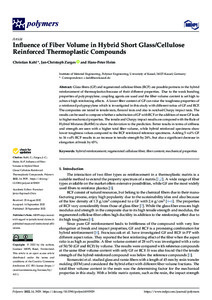Influence of Fiber Volume in Hybrid Short Glass/Cellulose Reinforced Thermoplastic Compounds
| dc.date.accessioned | 2022-10-28T10:02:36Z | |
| dc.date.available | 2022-10-28T10:02:36Z | |
| dc.date.issued | 2022-09-22 | |
| dc.identifier | doi:10.17170/kobra-202210287050 | |
| dc.identifier.uri | http://hdl.handle.net/123456789/14223 | |
| dc.description | Gefördert durch den Publikationsfonds der Universität Kassel | |
| dc.language.iso | eng | |
| dc.rights | Namensnennung 4.0 International | * |
| dc.rights.uri | http://creativecommons.org/licenses/by/4.0/ | * |
| dc.subject | hybrid reinforcementg | en |
| dc.subject | regenerated cellulose fiber | eng |
| dc.subject | fiber content | eng |
| dc.subject | mechanical properties | eng |
| dc.subject.ddc | 600 | |
| dc.title | Influence of Fiber Volume in Hybrid Short Glass/Cellulose Reinforced Thermoplastic Compounds | eng |
| dc.type | Aufsatz | |
| dcterms.abstract | Glass fibers (GF) and regenerated cellulose fibers (RCF) are possible partners in the hybrid reinforcement of thermoplastics because of their different properties. Due to the weak bonding properties of polypropylene, coupling agents are used and the fiber volume content is set high to achieve high reinforcing effects. A lower fiber content of GF can raise the toughness properties of a reinforced polypropylene which is investigated in this study with different ratios of GF and RCF. The composites are tested in tensile tests, flexural tests and also in notched Charpy impact tests. The results can be used to compare whether a substitution of GF with RCF or the addition of more GF leads to higher mechanical properties. The tensile and Charpy impact results are compared with the Rule of Hybrid Mixtures (RoHM) to show the deviation to the prediction. Better results in terms of stiffness and strength are seen with a higher total fiber volume, while hybrid reinforced specimens show lower toughness values compared to the RCF reinforced reference specimens. Adding 5 vol% GF to 16 vol% RCF results in an increase in tensile strength by 26%, but also a significant decrease in elongation at break by 65%. | eng |
| dcterms.accessRights | open access | |
| dcterms.creator | Kahl, Christian | |
| dcterms.creator | Zarges, Jan-Christoph | |
| dcterms.creator | Heim, Hans-Peter | |
| dc.relation.doi | doi:10.3390/polym14193929 | |
| dc.subject.swd | Glasfaser | ger |
| dc.subject.swd | Cellulosefaser | ger |
| dc.subject.swd | Mechanische Eigenschaft | ger |
| dc.subject.swd | Hybridtechnik | ger |
| dc.subject.swd | Thermoplastizität | ger |
| dc.type.version | publishedVersion | |
| dcterms.source.identifier | eissn:2073-4360 | |
| dcterms.source.issue | Issue 19 | |
| dcterms.source.journal | Polymers | eng |
| dcterms.source.volume | Volume 14 | |
| kup.iskup | false | |
| dcterms.source.articlenumber | 3929 |
Dateien zu dieser Ressource
Das Dokument erscheint in:
-
Artikel [1221]


